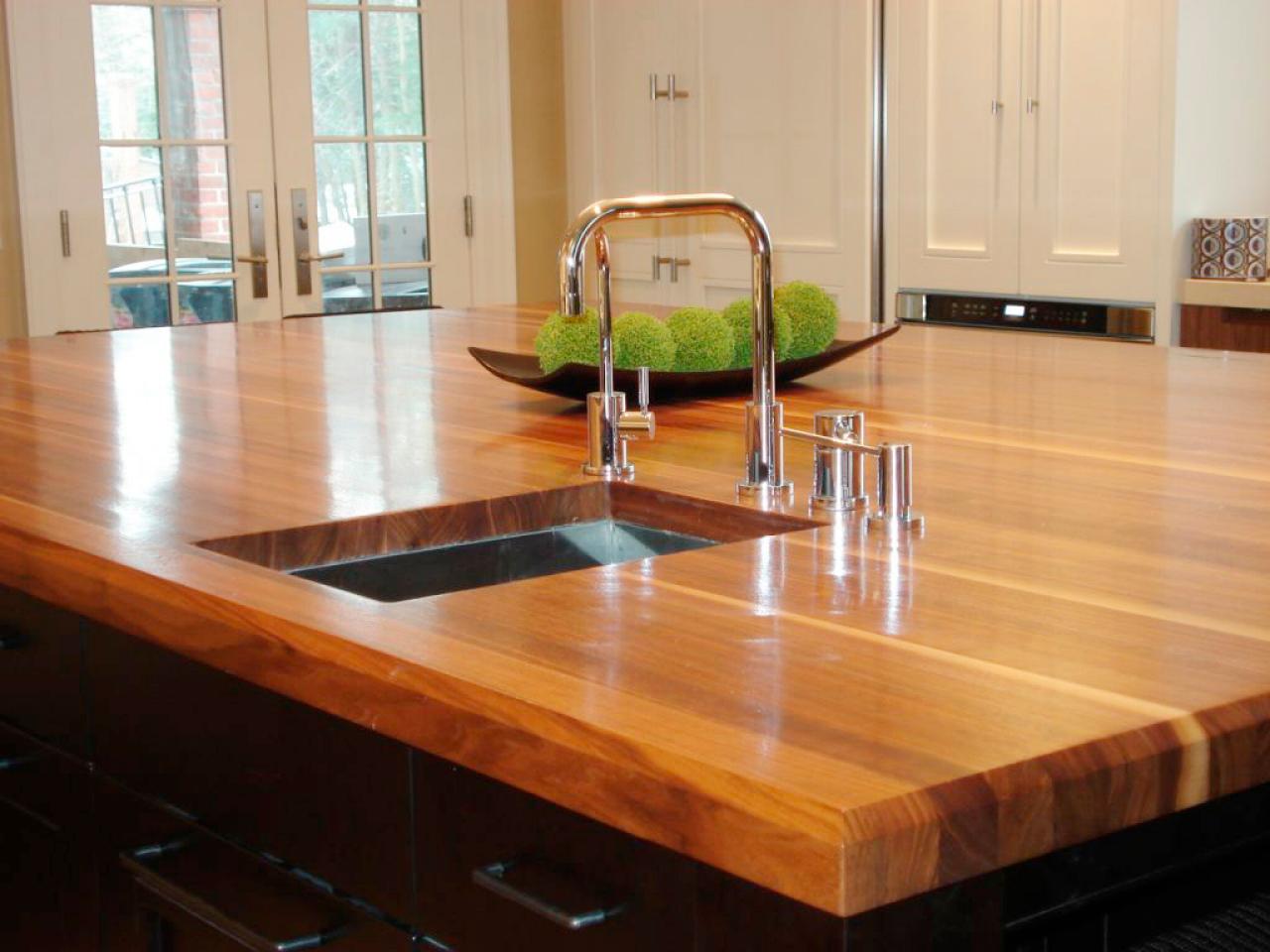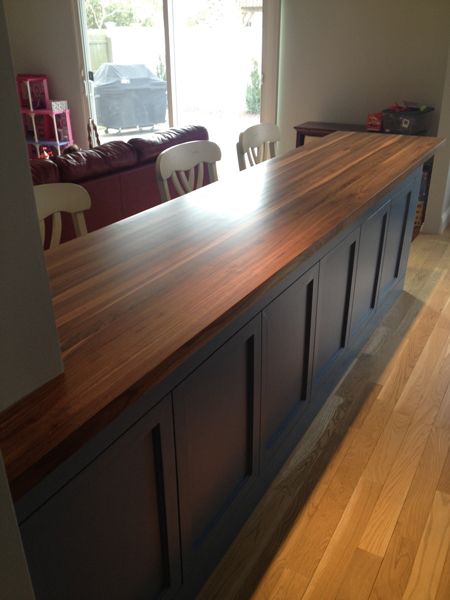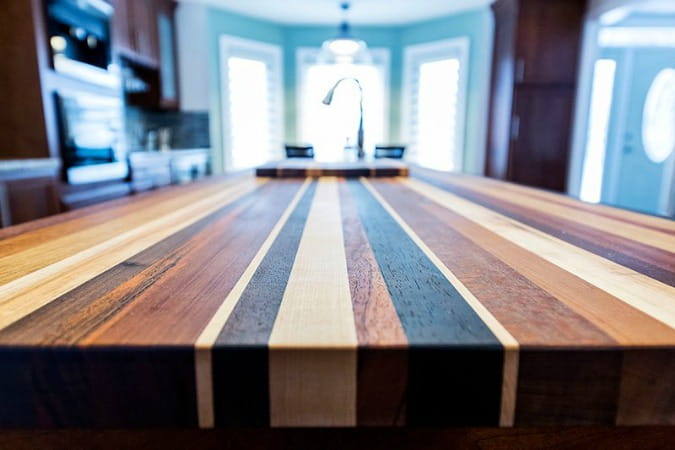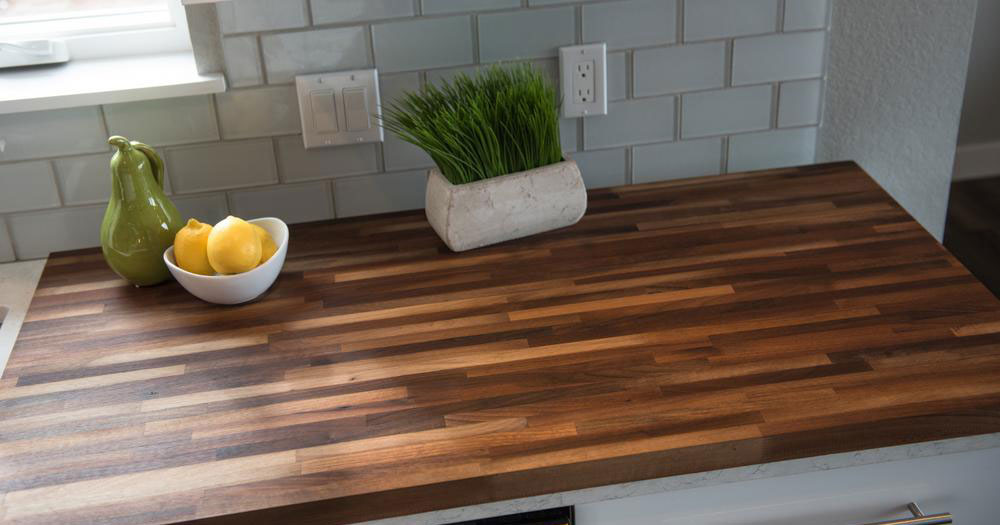When considering materials for butcher block countertops, the type of wood used plays a critical role in both the aesthetics and functionality of the surface. One of the most popular and traditional choices is maple. Hard maple is particularly renowned for its fine grain, durability, and resistance to wear and tear. It also boasts a natural, light color that complements various kitchen designs, from modern to rustic. Additionally, maple’s tight grain structure makes it less prone to bacterial growth, an essential factor for surfaces involved in food preparation. For those seeking a timeless look combined with practical benefits, maple remains a top contender.
Another excellent choice for butcher block countertops is walnut. Walnut wood is celebrated for its rich, dark hues that add a touch of luxury and warmth to kitchen interiors. The natural beauty of walnut lies in its complex grain patterns and deep, varied tones, ranging from light brown to dark chocolate. Walnut is also known for its strength and shock resistance, making it a durable option for a countertop that will see daily use. Despite its darker color, walnut maintains a smooth finish that can be easily cleaned and maintained, ensuring it remains a focal point in any kitchen setting.
Oak is another highly regarded wood for butcher block countertops, especially for those who favor a more traditional or farmhouse aesthetic. Oak is available in both red and white varieties, each offering distinct visual characteristics. Red oak typically has a more pronounced grain and a warmer, reddish hue, while white oak presents a subtler grain with a more neutral color palette. Both types are incredibly hard and dense, providing a sturdy work surface. Oak’s resilience to wear and its ability to be sanded and refinished multiple times extend its lifespan, making it a practical investment for the long term.
For those seeking an exotic and visually striking option, teak wood is worth considering. Teak’s high oil content gives it a natural resistance to water, decay, and insects, which is why it’s often used in outdoor furniture and boat building. This inherent durability makes teak an excellent choice for butcher block countertops, especially in kitchens with high humidity or heavy use. Teak’s rich, golden-brown color and straight grain pattern add a touch of elegance and sophistication, making it not just a functional surface but also a statement piece in any kitchen.

Cherry wood, with its distinctive warm, reddish-brown hue, is another beautiful choice for butcher block countertops. Over time, cherry wood darkens and develops a rich patina, adding character and depth to its appearance. This aging process is highly valued by those who appreciate the natural evolution of wood’s beauty. Cherry’s fine, smooth grain makes it a joy to work with, and its medium hardness ensures it stands up well to daily kitchen activities while remaining relatively easy to sand and refinish.
Bamboo, although technically a grass, is another material gaining popularity for butcher block countertops. Its sustainability is a significant draw, as bamboo grows rapidly and can be harvested without causing environmental damage. Bamboo countertops are known for their strength and durability, rivaling that of hardwoods. They also have a unique, contemporary look, with a consistent, light color and a distinctive grain pattern. Bamboo’s resistance to moisture and its natural antibacterial properties make it a practical choice for kitchen surfaces.
Acacia wood is another emerging favorite for butcher block countertops due to its durability and aesthetic appeal. Acacia is a dense hardwood with a distinctive grain pattern and a wide range of color variations, from light amber to dark mahogany. This wood is not only hard and water-resistant but also relatively easy to work with, making it suitable for countertops that need to withstand heavy use. Acacia’s natural beauty and resilience make it a valuable addition to any kitchen, offering both functionality and a touch of exotic charm.

Beech wood is often overlooked but is an excellent choice for butcher block countertops. Known for its light, warm color and smooth, consistent grain, beech provides a neutral backdrop that can fit well in various kitchen styles. Beech is a hard, dense wood, making it durable and resistant to impacts and scratches. Additionally, beech’s fine grain structure makes it less likely to harbor bacteria, a crucial consideration for food preparation surfaces. Its ability to be easily stained or left natural offers versatility in achieving the desired kitchen aesthetic.
Hickory wood stands out for its extreme hardness and unique appearance. With striking grain patterns that combine light and dark streaks, hickory offers a rustic, yet refined look that can add character to any kitchen. Its strength and durability are among the highest of North American hardwoods, making hickory butcher block countertops highly resistant to wear and damage. Despite its toughness, hickory can be sanded and refinished to maintain its beauty over time, ensuring a long-lasting and functional surface.
Ash wood is another viable option for butcher block countertops, appreciated for its strength and distinctive grain. Ash has a light color and a straight, open grain pattern, giving it a modern and clean appearance. This hardwood is known for its flexibility and shock resistance, making it durable enough to withstand the rigors of daily kitchen use. Ash’s relatively light weight compared to other hardwoods also makes it easier to handle and install. Its natural beauty and resilience make it a practical and stylish choice for any kitchen.
Mahogany, though less common, is another excellent choice for those seeking a luxurious and high-quality butcher block countertop. Known for its deep, reddish-brown color and fine grain, mahogany exudes elegance and sophistication. This hardwood is highly durable and resistant to moisture, making it suitable for kitchen environments. Mahogany’s ability to develop a beautiful patina over time adds to its appeal, ensuring that the countertop remains a focal point in the kitchen for years to come.

Birch wood is a practical and affordable option for butcher block countertops. Birch has a pale color with a fine, even grain, offering a clean and understated look that can complement various kitchen styles. Despite being slightly softer than other hardwoods like maple or oak, birch is still durable and resilient enough for regular kitchen use. Its smooth texture makes it easy to sand and finish, providing flexibility in achieving the desired look and feel for the countertop.
Rubberwood, another sustainable choice, is increasingly popular for butcher block countertops. Sourced from rubber trees that have completed their latex-producing cycle, rubberwood is an eco-friendly option that offers excellent durability and a light, uniform color. Its fine grain and smooth texture make it easy to work with and finish, allowing for a wide range of design possibilities. Rubberwood’s resistance to warping and cracking ensures a long-lasting and stable countertop surface.
Another exotic option is zebrawood, known for its striking, zebra-like grain pattern. Zebrawood offers a unique and bold look that can make a statement in any kitchen. This hardwood is highly durable and resistant to wear, making it suitable for high-traffic areas. Despite its distinctive appearance, zebrawood is relatively easy to work with and finish, providing a combination of beauty and practicality for butcher block countertops.
Butcher block countertops made from reclaimed wood are an environmentally friendly choice that adds character and history to the kitchen. Reclaimed wood can come from various sources, such as old barns, factories, or even wine barrels, each piece carrying a unique story and appearance. Using reclaimed wood not only reduces waste but also offers a unique aesthetic that new wood cannot replicate. The natural patina, nail holes, and weathered grain patterns of reclaimed wood create a distinctive and charming surface that adds warmth and personality to any kitchen.
 Common Mistakes to Avoid
Common Mistakes to Avoid
When choosing wood for butcher block countertops, one common mistake is not considering the wood’s hardness and durability. Softer woods, while often more affordable, may not withstand the heavy use that kitchen countertops typically endure. It’s essential to choose a hardwood that can resist scratches, dents, and other forms of wear.
Another mistake is neglecting the maintenance requirements. Butcher block countertops need regular oiling to keep the wood hydrated and prevent cracking. Failing to maintain the wood properly can lead to premature aging and damage. Additionally, not accounting for wood movement due to changes in humidity and temperature can result in warping or splitting.
Proper installation techniques and allowing for expansion and contraction are crucial to avoid these issues. Finally, overlooking the importance of food safety can be problematic. Some woods are naturally more resistant to bacteria, while others may need additional sealing or treatment to ensure they remain safe for food preparation.
 What is the best wood for a butcher block countertop?
What is the best wood for a butcher block countertop?
Maple is often considered the best wood for butcher block countertops due to its hardness, fine grain, and light color. It offers a combination of durability, aesthetic appeal, and resistance to bacteria, making it a practical and beautiful choice for kitchen surfaces. Other excellent options include walnut for its rich color, oak for its durability, and teak for its water resistance.
How do I maintain a butcher block countertop?
Maintaining a butcher block countertop involves regular oiling to keep the wood hydrated and prevent cracking. Food-grade mineral oil is commonly used for this purpose. It’s also essential to clean the surface properly with mild soap and water, avoiding harsh chemicals that can damage the wood. Sanding and refinishing may be necessary over time to remove stains or scratches and restore the countertop’s original appearance.
Can I cut directly on a butcher block countertop?
While butcher block countertops are designed for food preparation, it’s generally advisable to use a cutting board to protect the surface. Cutting directly on the countertop can cause scratches and knife marks, which, although can be sanded out, may reduce the countertop’s lifespan and aesthetic appeal. Additionally, using a cutting board helps maintain the countertop’s finish and hygiene.
Is bamboo a good choice for butcher block countertops?
Yes, bamboo is a good choice for butcher block countertops. It is strong, durable, and environmentally friendly due to its rapid growth rate and sustainability. Bamboo has natural antibacterial properties and a unique, modern appearance. However, it is essential to ensure the bamboo is properly treated and sealed to prevent moisture damage and maintain its structural integrity.
How long do butcher block countertops last?
With proper care and maintenance, butcher block countertops can last for decades. Regular oiling, cleaning, and occasional sanding and refinishing will help preserve the wood’s appearance and functionality. The type of wood used also affects longevity, with harder woods like maple, oak, and walnut typically offering longer-lasting surfaces compared to softer woods.

Are Wood Countertops a Good Idea?

Butcher Block Countertops

Size and Wood Species Options for DIY Butcher Block Projects

Custom Butcher Block Countertops – Hardwood Lumber Company

Related articles:


 Birch wood is a practical and affordable option for butcher block countertops. Birch has a pale color with a fine, even grain, offering a clean and understated look that can complement various kitchen styles. Despite being slightly softer than other hardwoods like maple or oak, birch is still durable and resilient enough for regular kitchen use. Its smooth texture makes it easy to sand and finish, providing flexibility in achieving the desired look and feel for the countertop.
Rubberwood, another sustainable choice, is increasingly popular for butcher block countertops. Sourced from rubber trees that have completed their latex-producing cycle, rubberwood is an eco-friendly option that offers excellent durability and a light, uniform color. Its fine grain and smooth texture make it easy to work with and finish, allowing for a wide range of design possibilities. Rubberwood’s resistance to warping and cracking ensures a long-lasting and stable countertop surface.
Another exotic option is zebrawood, known for its striking, zebra-like grain pattern. Zebrawood offers a unique and bold look that can make a statement in any kitchen. This hardwood is highly durable and resistant to wear, making it suitable for high-traffic areas. Despite its distinctive appearance, zebrawood is relatively easy to work with and finish, providing a combination of beauty and practicality for butcher block countertops.
Butcher block countertops made from reclaimed wood are an environmentally friendly choice that adds character and history to the kitchen. Reclaimed wood can come from various sources, such as old barns, factories, or even wine barrels, each piece carrying a unique story and appearance. Using reclaimed wood not only reduces waste but also offers a unique aesthetic that new wood cannot replicate. The natural patina, nail holes, and weathered grain patterns of reclaimed wood create a distinctive and charming surface that adds warmth and personality to any kitchen.
Birch wood is a practical and affordable option for butcher block countertops. Birch has a pale color with a fine, even grain, offering a clean and understated look that can complement various kitchen styles. Despite being slightly softer than other hardwoods like maple or oak, birch is still durable and resilient enough for regular kitchen use. Its smooth texture makes it easy to sand and finish, providing flexibility in achieving the desired look and feel for the countertop.
Rubberwood, another sustainable choice, is increasingly popular for butcher block countertops. Sourced from rubber trees that have completed their latex-producing cycle, rubberwood is an eco-friendly option that offers excellent durability and a light, uniform color. Its fine grain and smooth texture make it easy to work with and finish, allowing for a wide range of design possibilities. Rubberwood’s resistance to warping and cracking ensures a long-lasting and stable countertop surface.
Another exotic option is zebrawood, known for its striking, zebra-like grain pattern. Zebrawood offers a unique and bold look that can make a statement in any kitchen. This hardwood is highly durable and resistant to wear, making it suitable for high-traffic areas. Despite its distinctive appearance, zebrawood is relatively easy to work with and finish, providing a combination of beauty and practicality for butcher block countertops.
Butcher block countertops made from reclaimed wood are an environmentally friendly choice that adds character and history to the kitchen. Reclaimed wood can come from various sources, such as old barns, factories, or even wine barrels, each piece carrying a unique story and appearance. Using reclaimed wood not only reduces waste but also offers a unique aesthetic that new wood cannot replicate. The natural patina, nail holes, and weathered grain patterns of reclaimed wood create a distinctive and charming surface that adds warmth and personality to any kitchen.
 Common Mistakes to Avoid
When choosing wood for butcher block countertops, one common mistake is not considering the wood’s hardness and durability. Softer woods, while often more affordable, may not withstand the heavy use that kitchen countertops typically endure. It’s essential to choose a hardwood that can resist scratches, dents, and other forms of wear.
Another mistake is neglecting the maintenance requirements. Butcher block countertops need regular oiling to keep the wood hydrated and prevent cracking. Failing to maintain the wood properly can lead to premature aging and damage. Additionally, not accounting for wood movement due to changes in humidity and temperature can result in warping or splitting.
Proper installation techniques and allowing for expansion and contraction are crucial to avoid these issues. Finally, overlooking the importance of food safety can be problematic. Some woods are naturally more resistant to bacteria, while others may need additional sealing or treatment to ensure they remain safe for food preparation.
Common Mistakes to Avoid
When choosing wood for butcher block countertops, one common mistake is not considering the wood’s hardness and durability. Softer woods, while often more affordable, may not withstand the heavy use that kitchen countertops typically endure. It’s essential to choose a hardwood that can resist scratches, dents, and other forms of wear.
Another mistake is neglecting the maintenance requirements. Butcher block countertops need regular oiling to keep the wood hydrated and prevent cracking. Failing to maintain the wood properly can lead to premature aging and damage. Additionally, not accounting for wood movement due to changes in humidity and temperature can result in warping or splitting.
Proper installation techniques and allowing for expansion and contraction are crucial to avoid these issues. Finally, overlooking the importance of food safety can be problematic. Some woods are naturally more resistant to bacteria, while others may need additional sealing or treatment to ensure they remain safe for food preparation.
 What is the best wood for a butcher block countertop?
Maple is often considered the best wood for butcher block countertops due to its hardness, fine grain, and light color. It offers a combination of durability, aesthetic appeal, and resistance to bacteria, making it a practical and beautiful choice for kitchen surfaces. Other excellent options include walnut for its rich color, oak for its durability, and teak for its water resistance.
How do I maintain a butcher block countertop?
Maintaining a butcher block countertop involves regular oiling to keep the wood hydrated and prevent cracking. Food-grade mineral oil is commonly used for this purpose. It’s also essential to clean the surface properly with mild soap and water, avoiding harsh chemicals that can damage the wood. Sanding and refinishing may be necessary over time to remove stains or scratches and restore the countertop’s original appearance.
Can I cut directly on a butcher block countertop?
While butcher block countertops are designed for food preparation, it’s generally advisable to use a cutting board to protect the surface. Cutting directly on the countertop can cause scratches and knife marks, which, although can be sanded out, may reduce the countertop’s lifespan and aesthetic appeal. Additionally, using a cutting board helps maintain the countertop’s finish and hygiene.
Is bamboo a good choice for butcher block countertops?
Yes, bamboo is a good choice for butcher block countertops. It is strong, durable, and environmentally friendly due to its rapid growth rate and sustainability. Bamboo has natural antibacterial properties and a unique, modern appearance. However, it is essential to ensure the bamboo is properly treated and sealed to prevent moisture damage and maintain its structural integrity.
How long do butcher block countertops last?
With proper care and maintenance, butcher block countertops can last for decades. Regular oiling, cleaning, and occasional sanding and refinishing will help preserve the wood’s appearance and functionality. The type of wood used also affects longevity, with harder woods like maple, oak, and walnut typically offering longer-lasting surfaces compared to softer woods.
What is the best wood for a butcher block countertop?
Maple is often considered the best wood for butcher block countertops due to its hardness, fine grain, and light color. It offers a combination of durability, aesthetic appeal, and resistance to bacteria, making it a practical and beautiful choice for kitchen surfaces. Other excellent options include walnut for its rich color, oak for its durability, and teak for its water resistance.
How do I maintain a butcher block countertop?
Maintaining a butcher block countertop involves regular oiling to keep the wood hydrated and prevent cracking. Food-grade mineral oil is commonly used for this purpose. It’s also essential to clean the surface properly with mild soap and water, avoiding harsh chemicals that can damage the wood. Sanding and refinishing may be necessary over time to remove stains or scratches and restore the countertop’s original appearance.
Can I cut directly on a butcher block countertop?
While butcher block countertops are designed for food preparation, it’s generally advisable to use a cutting board to protect the surface. Cutting directly on the countertop can cause scratches and knife marks, which, although can be sanded out, may reduce the countertop’s lifespan and aesthetic appeal. Additionally, using a cutting board helps maintain the countertop’s finish and hygiene.
Is bamboo a good choice for butcher block countertops?
Yes, bamboo is a good choice for butcher block countertops. It is strong, durable, and environmentally friendly due to its rapid growth rate and sustainability. Bamboo has natural antibacterial properties and a unique, modern appearance. However, it is essential to ensure the bamboo is properly treated and sealed to prevent moisture damage and maintain its structural integrity.
How long do butcher block countertops last?
With proper care and maintenance, butcher block countertops can last for decades. Regular oiling, cleaning, and occasional sanding and refinishing will help preserve the wood’s appearance and functionality. The type of wood used also affects longevity, with harder woods like maple, oak, and walnut typically offering longer-lasting surfaces compared to softer woods.




 Related articles:
Related articles: